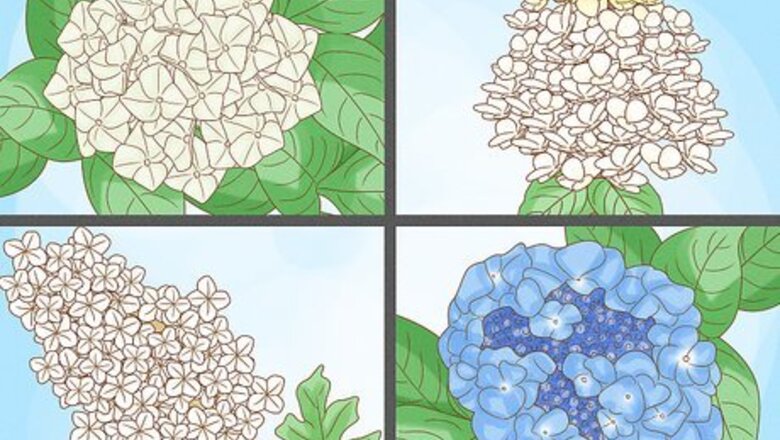
views
Planting Hydrangeas
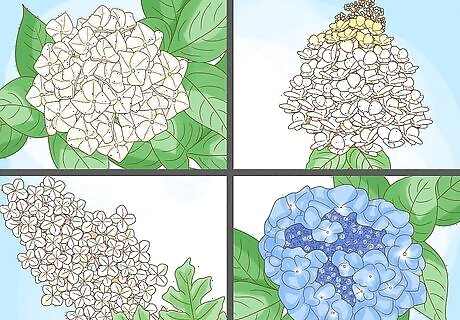
Choose a hydrangea variety. In order to figure out what type of hydrangea to plant, you'll need to figure out which variety is best for your gardening zone. Start by looking at a planting zone hardiness map to determine the number of your zone. There are hundreds of varieties of hydrangeas to choose from. If this is your first time planting these beautiful flowers, you may want to choose from among these common varieties that are known to be hardy and produce long-lasting blooms. Mophead and lacecap hydrangeas, or "bigleaf" hydrangeas, don't do as well in colder regions unless you take measures to protect them from frost. Look for the "Endless Summer" mop-head variety at your local nursery - it's a type of mophead hydrangea that blooms more than once over the summer. This type of hydrangea produces large balls of pink or blue blossoms that deepen in color over the course of the season. The oakleaf hydrangea grows well in places with very hot summers without too much moisture. It is hardy through zone 4b/5a. This type of hydrangea has white blossoms. Annabelle hydrangeas are more cold hardy than mophead or oakleaf hydrangeas, can still grow in zone 3. This type of hydrangea has white blossoms that turn light green later in the season. Peegee hydrangeas can grow hardy even further north than Annabelles - all the way up to zone 3a. They are also able to grow in southern zones. They have white blossoms.
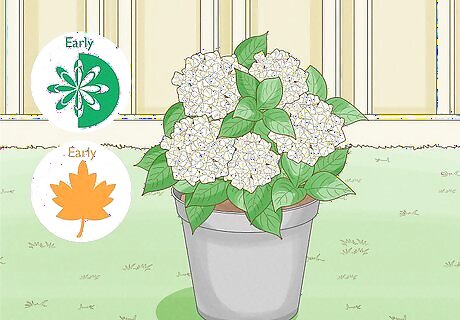
Plan to plant in the spring or fall. Planting in one of these milder seasons will give the hydrangeas time to acclimate to the soil conditions and take root before the weather gets more extreme. Look for hydrangea plants in your nursery in early spring or early fall.
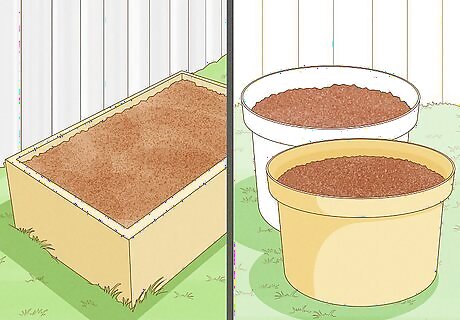
Find a good planting spot. Hydrangeas are easy to grow either in planting beds or in large pots. Whichever method you choose, you'll need a spot that gets full sun in the morning and partial shade in the afternoon. Bigleaf hydrangeas will grow in complete partial shade, so choose this variety if you have a shady yard.
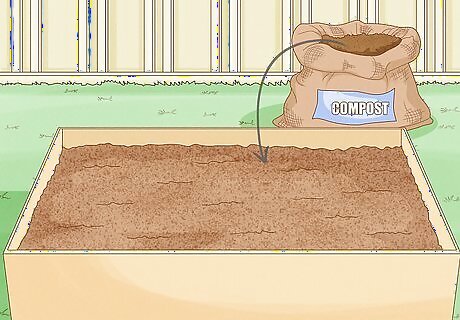
Enrich the soil with compost. Hydrangeas need rich, well-drained soil that is kept moist. If you're working with dry or depleted soil, get it ready for hydrangeas by working in some compost. If your soil tends to hold water, you can add peat to help with drainage.

Dig a wide hole in the soil. The hold you dig should be as deep as the root ball on the hydrangea plant, and at least twice as wide. Use a spade or shovel to dig a big hole to accommodate the plant's roots. If you're planting more than one hydrangea, they should be spaced 5–7 feet (1.5–2.1 m) apart, since the plants can grow to get very large. Check the instructions that came with your particular hydrangea variety. Some hydrangeas can be planted closer together, while others may need to be planted at least 10 feet (3.0 m) apart.
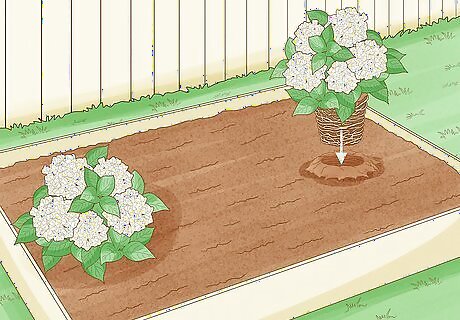
Plant the hydrangea. It's important to make sure the roots of the hydrangea get watered at the time of planting, so start by setting the hydrangea's root ball in the hole you dug. Fill the hole with soil and then give it water. Pat the soil down around the base of the hydrangea. Planting hydrangeas too deeply can cause the roots to fail. If not planted deep enough, your hydrangeas could fall over in heavy rain or strong wind.
Caring for Hydrangeas
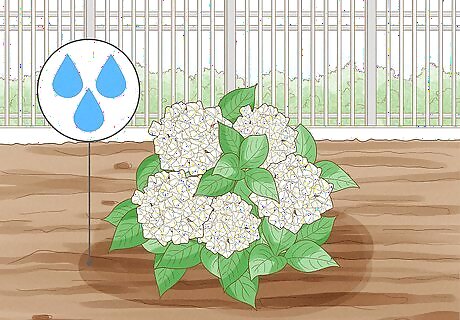
Keep the soil moist. Hydrangeas will begin to wilt if the soil gets too dry, so make sure you water them every day or two, especially during the hot summer months. Water the hydrangeas near the base of the plants and above the roots, rather than spraying the water directly onto the flowers; this prevents the flowers from getting burned by the sun.
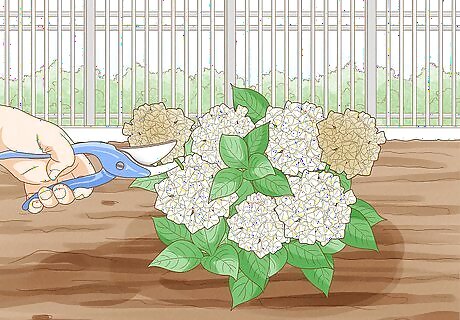
Prune only when necessary. New hydrangeas do not need to be pruned; if you do so, you may not get new blossoms the following spring. If you have older hydrangeas that have gotten quite large and need to be cut back, make sure you prune at the right time of year according to the variety of hydrangea you planted. Bigleaf hydrangea varieties should be pruned after the blossoms have faded in the late summer. Pee Gee Hydrangea (H. paniculata), also known as Panicle, are best pruned in late winter or early spring or fall. This variety blooms on the current season’s wood, so go easy on pruning. Don’t cut to the ground unless your bush is getting too big. Annabelle Hydrangea (H. arborescens) can be lightly pruned in the summer after the spring bloom, or cut down to the ground in late winter. Oakleaf and other hydrangeas that bloom on the current season's wood should be pruned while the plant is still dormant, in late winter or early spring, before the blooms emerge.

Protect hydrangeas over the winter. Cover them with mulch, straw, or pine needles to a depth of at least 18 inches (45.7 cm). If you have smaller bushes, you can cover the entire plant for the winter. Remove the cover in early spring, after the last frost. Use chicken wire or some other small fence like cage to help mulch stay around plant’s crown.
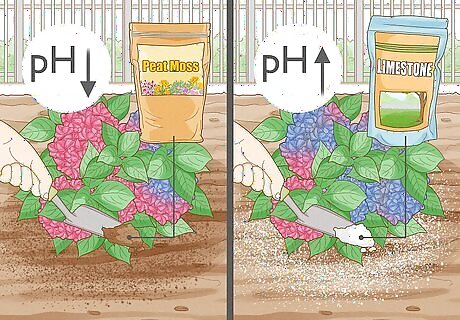
Change the color of hydrangeas. The color of hydrangeas depends on the pH of the soil in which they are planted. If you have pink or blue hydrangeas, it's possible to change their color by changing the soil's pH. This can take weeks or months, so be patient! Wait until your plant has been in the garden at least two years before attempting color change. To change flowers from pink to blue, lower the soil's pH by adding sulfur or peat moss. To change flowers from blue to pink (which is more difficult than changing from pink to blue), add limestone to the soil to raise the soil's pH. White hydrangea blossoms don't change color. Gently mix in soil amendments into the first few inches of soil around your plant’s roots.
Cutting and Drying Hydrangeas

Harvest hydrangeas when the flowers are mature. Wait until the color is rich and the flowers have a papery, rather than juicy, consistency. This will make the flowers easier to dry. Use a scissors or pruning tool to cut the stems.
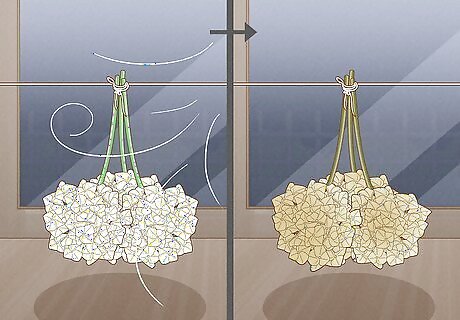
Dry hydrangeas to preserve them. Hydrangeas preserve beautifully when dried. Their color stays bright for a long time, and they hold their shape for years before disintegrating. To dry hydrangeas, use one of the following methods: Hang them upside down. Tape or pin the stems to the top of a doorway in a dry, dark room. Let them hang until they completely dry, then remove them and arrange them in a vase. Dry them in water. Place the stems in a vase filled with a few inches of water. Allow the flowers to slowly dry as the water evaporates. Use silica gel. Place the blossoms in a container and cover completely with silica gel. After a week or two, the flowers will be dry, their color perfectly preserved.




















Comments
0 comment